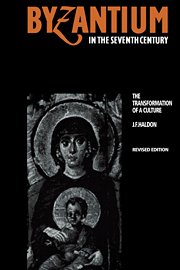Book contents
- Frontmatter
- Contents
- List of plates
- List of maps
- Preface and acknowledgements
- Preface to the revised edition
- List of abbreviations
- The sources
- Introduction
- 1 The background: state and society before Heraclius
- 2 The East Roman world c. 610–717: the politics of survival
- 3 Social relations and the economy: the cities and the land
- 4 Social relations and the economy: rural society
- 5 The state and its apparatus: fiscal administration
- 6 The state and its apparatus: military administration
- 7 Society, state and law
- 8 The imperial church and the politics of authority
- 9 Religion and belief
- 10 Forms of social and cultural organisation: infrastructures and hierarchies
- 11 Forms of representation: language, literature and the icon
- Conclusion: The transformation of a culture
- Addendum: Further observations on the question of the late ancient city
- Bibliography
- Index
Conclusion: The transformation of a culture
Published online by Cambridge University Press: 13 November 2009
- Frontmatter
- Contents
- List of plates
- List of maps
- Preface and acknowledgements
- Preface to the revised edition
- List of abbreviations
- The sources
- Introduction
- 1 The background: state and society before Heraclius
- 2 The East Roman world c. 610–717: the politics of survival
- 3 Social relations and the economy: the cities and the land
- 4 Social relations and the economy: rural society
- 5 The state and its apparatus: fiscal administration
- 6 The state and its apparatus: military administration
- 7 Society, state and law
- 8 The imperial church and the politics of authority
- 9 Religion and belief
- 10 Forms of social and cultural organisation: infrastructures and hierarchies
- 11 Forms of representation: language, literature and the icon
- Conclusion: The transformation of a culture
- Addendum: Further observations on the question of the late ancient city
- Bibliography
- Index
Summary
PIETY AND SECURITY: THE POLES OF AUTHORITY
The history of East Roman or Byzantine culture in the later sixth and seventh centuries can be most easily represented in terms of two dominant motifs: the increasing introversion of orthodox culture and the quest for security. By the former, I mean the generalised concentration in the thinking of the society as a whole on the personal relationship of individuals to God, the identity of orthodox thinking with the survival of the Roman oikoumenē, and the exclusion of all marginal or heterodox groups from consideration, in a much more emphatic way than had been the case before the last years of Justinian. By the latter, I mean the manifest collapse of confidence in the traditional symbols of earthly supremacy, in particular the institutions of the imperial establishment, and the search for ways in which an imagined older order – of stability and confidence – could be recovered, which would fulfil the desire both to conform to the spirit and the letter of Chalcedonian orthodoxy, and at the same time to reassert the political dominance of East Rome and the symbolic universe it represented. The first is evident in the literary texts of the period; the second is implicit in the assumptions, actions and responses of individuals and groups within Byzantine society in the period from the 640s and beyond.
These two motifs were, of course, inseparable, since the maintenance of orthodoxy and the exclusion of heterodoxy automatically – it was believed – brought with it, ultimately, political supremacy, at least until the events immediately preceding the Last Judgement.
- Type
- Chapter
- Information
- Byzantium in the Seventh CenturyThe Transformation of a Culture, pp. 436 - 458Publisher: Cambridge University PressPrint publication year: 1990

